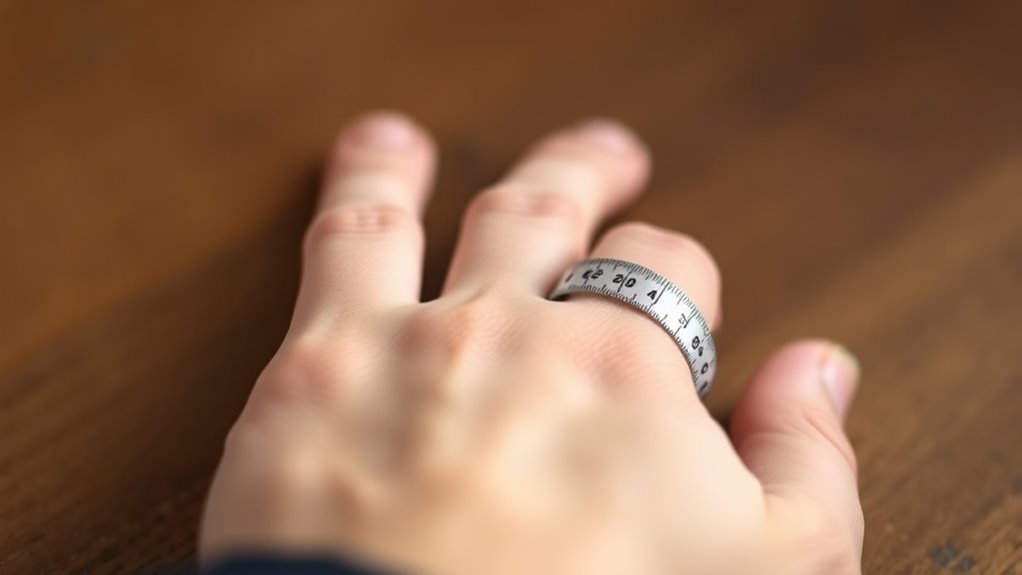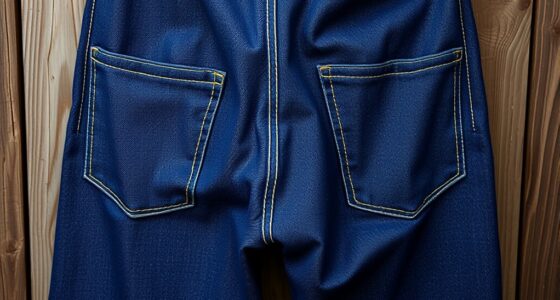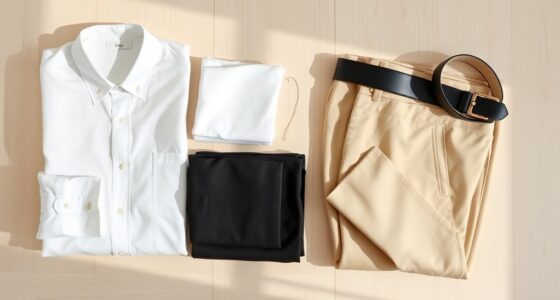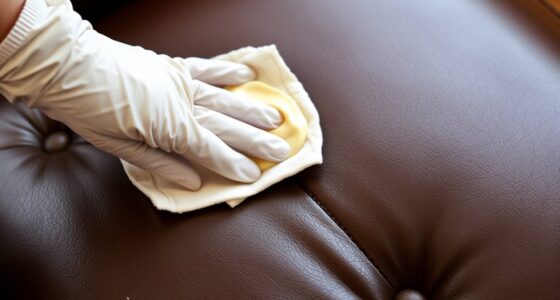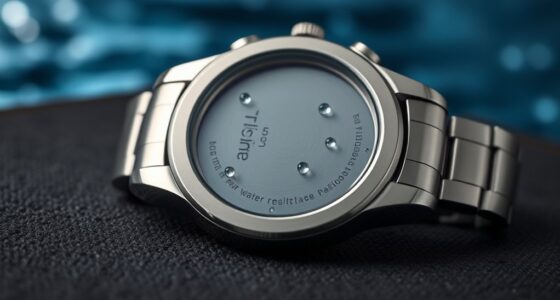To measure your ring size at home, start by gathering materials like a strip of paper, flexible measuring tape, or string. Wrap the material snugly around your finger or an existing ring that fits well, then mark where it overlaps. Use a ruler to measure the marked length or circumference. Match this measurement to a ring size chart for the perfect fit. If you want more detailed tips, keep exploring to find out how to get the best results.
Key Takeaways
- Use a flexible measuring tape, string, or paper strip to wrap around your finger comfortably.
- Mark the point where the material overlaps to determine the circumference.
- Measure the marked length with a ruler in millimeters for accuracy.
- Compare the measurement against a trusted ring size chart to find your size.
- For best results, measure at different times and choose the larger size if between two options.
Gather Your Materials
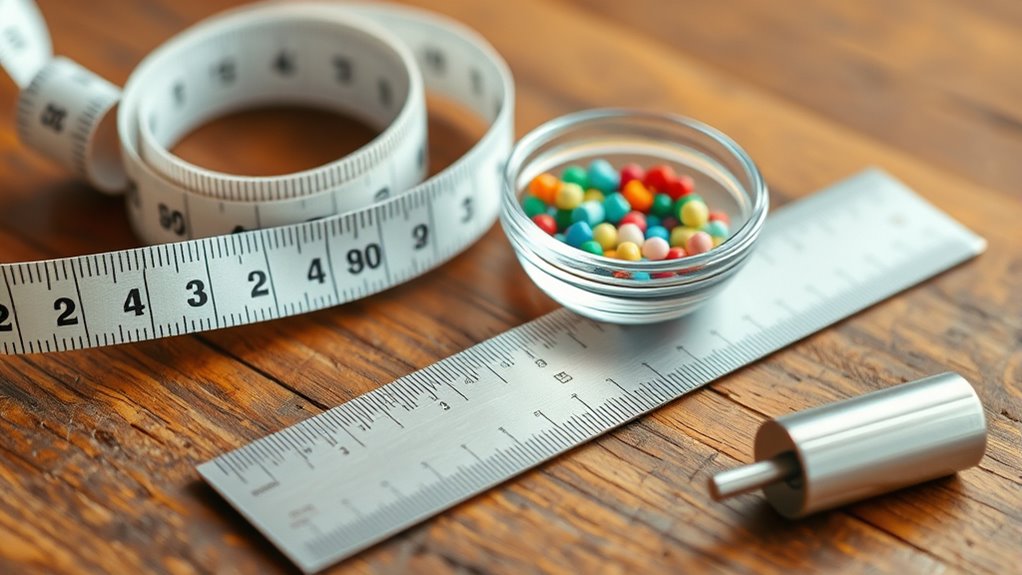
To measure your ring size accurately, you’ll need to gather a few simple materials. First, choose a metal type for your ring, such as gold, silver, or platinum, depending on your preference and skin sensitivity. The metal type can affect ring comfort, so pick one that feels comfortable on your skin. You’ll also need a thin strip of paper, a flexible measuring tape, or a piece of string. These tools will help you determine your finger’s circumference precisely. Make sure the materials you select are sturdy enough to hold their shape but flexible enough to wrap comfortably around your finger. Additionally, understanding ring sizing can help you select the most comfortable fit. Having these items ready ensures a smooth measurement process, giving you the most accurate ring size possible.
Measure Your Current Ring or Finger

Start by gathering a ring that already fits comfortably on the finger you want to measure. This ring will serve as your reference for determining your size. Use a trusted ring size chart to compare its inner diameter or circumference with standard measurements. Keep in mind that jewelry materials can affect fit; for example, softer metals like gold or silver may expand or contract slightly over time, so choose a well-fitting ring for accuracy. If you have multiple rings, pick the one that feels most comfortable and matches the finger size you want to measure. Avoid guessing or forcing the ring onto your finger, as this can lead to inaccuracies. Using a ring that already fits well helps ensure your measurements are precise and reliable. Additionally, material properties can influence how a ring fits over time, so selecting a sturdy and well-maintained ring can improve measurement consistency.
Create a Ring Sizing Paper or String Loop
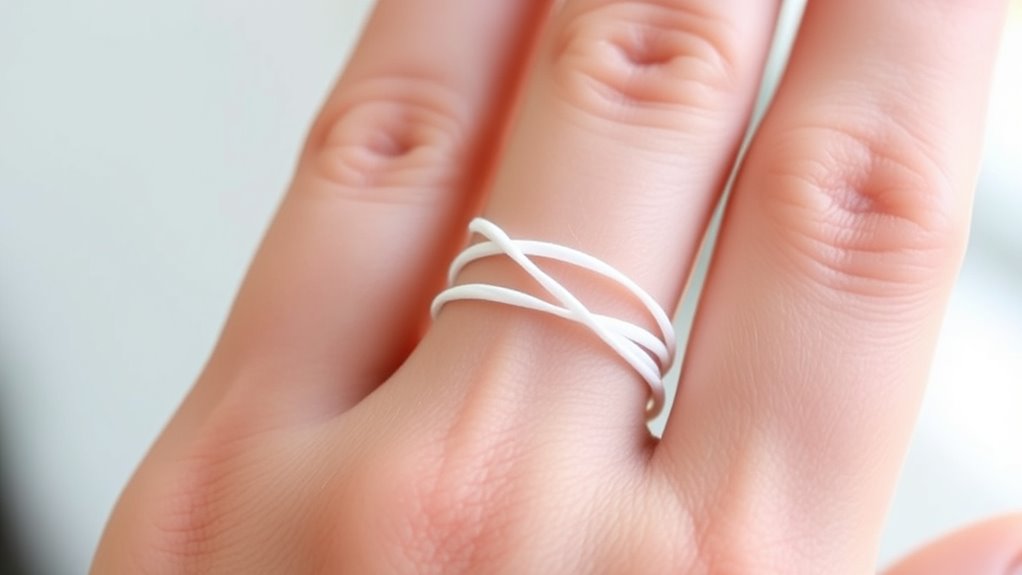
Creating a ring sizing paper or string loop is a simple way to measure your finger at home. You can choose from various material options, such as thin strips of paper, adhesive strips, or non-stretchy string. For better sizing accuracy, opt for a material that won’t stretch or slip, like a strip of cardstock or a durable string. Measure your finger’s circumference carefully, ensuring the paper or string fits snugly but comfortably around your finger. Mark where the material overlaps or meets, then measure that length with a ruler. Using the right material options helps prevent inaccuracies caused by stretching or slipping, ensuring your measurement reflects your true ring size. This method provides a reliable base for selecting a well-fitting ring. Automation technologies can also be incorporated into digital tools to help you record and compare measurements more precisely.
Record Your Measurement Accurately
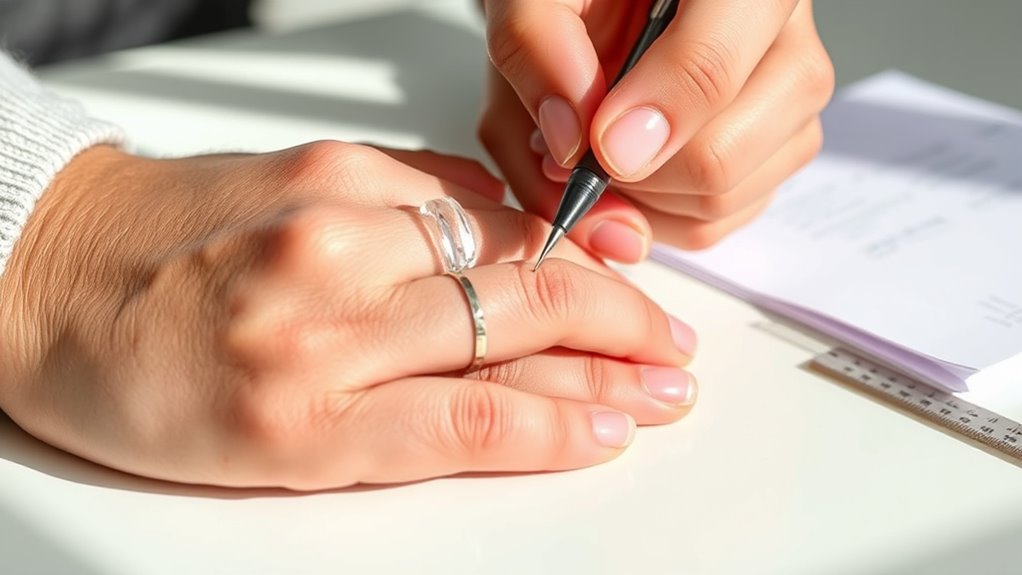
Once you’ve measured your finger with the paper or string, it’s important to record that measurement accurately. This guarantees your ring fits comfortably and suits your finger anatomy. Keep in mind that different jewelry materials may expand or contract slightly, so precise measurements matter. Use a pen to mark the measurement on your paper or note the string length. To stay organized, record your measurement in the table below:
| Measurement (in mm) | Notes |
|---|---|
| [Your measurement] | Measure at the widest part of your finger |
| Jewelry material | Example: Gold, silver |
| Finger area | Example: Middle joint |
| Date of measurement | [Insert date] |
| Additional comments | Any swelling or temperature changes |
Accurate recording helps you select the right ring size for your finger’s anatomy and ensures a comfortable fit, especially considering the tuning of your jewelry material for optimal comfort.
Determine Your Ring Size and Make Adjustments

After you’ve recorded your measurement, it’s important to determine your actual ring size and adjust if necessary. Use a reliable ring size chart to match your measurement to the standard sizes. Keep in mind that your finger size can vary slightly, so it’s wise to measure at different times of day or when your fingers are warm. If your measurement falls between sizes, opt for the larger one for comfort. If your ring doesn’t fit perfectly, jewelry resizing is an option—most jewelers can adjust your ring for a perfect fit. Knowing your accurate size helps prevent the hassle of resizing later. Always double-check your measurement and consult a trusted ring size chart before making your purchase or resizing decision. Additionally, understanding ring size standards can help you select the most accurate fit for your ring.
Frequently Asked Questions
How Often Should I Remeasure My Ring Size?
You should remeasure your ring size every few months, especially during seasonal fluctuations when your finger size might alter due to temperature or fluid retention. Additionally, if you experience weight changes or plan a special occasion like an engagement or wedding, remeasuring guarantees a perfect fit. Regular checks help you avoid discomfort or the risk of losing your ring, keeping your jewelry comfortable and secure.
Can I Measure My Ring Size With a Different Material?
Yes, you can measure your ring size with alternative materials like string, paper, or strips of fabric. Just make certain the material is thin and flexible for better measurement accuracy. Wrap it snugly around your finger without tightening too much. Mark where it overlaps, then compare the length to a ring size chart. Using these materials provides a quick, inexpensive way to get a reasonably accurate measurement at home.
What if My Finger Size Varies Throughout the Day?
Think of your finger like a river, flowing with changes. If your finger size varies due to swelling or temperature effects, measure it at different times of day—morning, afternoon, evening—to find an average. Keep in mind that finger swelling can make your size fluctuate, so choosing a slightly looser fit might be wise. This way, your ring stays comfortable no matter how your finger changes.
How Accurate Is Measuring With a String Compared to a Ring Sizer?
Measuring with a string can be fairly accurate if you follow proper techniques, but it’s not as precise as using official alternative measuring tools like a ring sizer. Common measurement mistakes include pulling the string too tight or too loose, which can lead to sizing errors. To improve accuracy, guarantee you measure at the end of the day when your fingers are their largest and double-check your measurements.
Should I Measure My Dominant or Non-Dominant Hand?
You should measure your non-dominant hand because it typically has less swelling and more stable finger size, providing a more accurate measurement. Keep in mind, hand swelling and finger flexibility can fluctuate throughout the day, so measure when your hand is relaxed and at a consistent temperature. This helps make sure the ring size you determine will fit comfortably and stay secure over time.
Conclusion
Now that you know how to measure your ring size at home, you’re equipped to find the perfect fit. Remember, a ring should slide on comfortably but stay secure—like a promise that fits just right. Your measurement is the key to your next special piece, so take your time and trust the process. After all, a well-fitting ring isn’t just jewelry—it’s a symbol of confidence and love that lasts beyond the moment.
